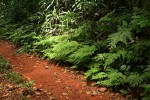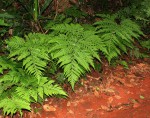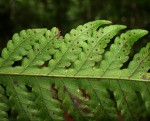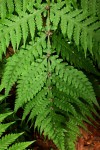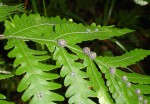Tectaria gemmifera (Fée) Alston
Synonyms |
Aspidium coadunatum Kaulf. var. gemmiferum (Fée) Mett. ex Kuhn |
|---|---|
Common name |
|
Description |
Rhizome erect, up to 13 cm high and 2 cm in diameter; rhizome scales lanceolate in outline, margins entire, apex tapering to a point, up to 9 mm long, dark brown with paler margins. Fronds monomorphic, tufted, arching, up to 1.8 m long, thinly herbaceous to coriaceous, with proliferating buds on rhachis, costae and costules on the upper surface. Stipe 30-75 cm long, straw-coloured to brown, shiny, thinly set with minute white hairs and with scales similar to those on the rhizome at the base. Lamina 2-pinnatifid to 3-pinnate with long pinnatifid terminal segment, basal pinnae longest and strongly developed basiscopically, ovate-triangular in outline, 30-100 × 23-80 cm; pinnae in 4-6 pairs, sparsely set with minute white hairs on both surfaces, denser on costae and costules and veins below; pinnules to 18 cm long; ultimate segments oblong-lanceolate in outline, falcate, margins crenate or incised into rounded lobes; veins and veinlets anastomosing; free included veinlets in areoles not frequent, absent along the rhachis and rare in the triangular areoles between rachis and costa. Sori up to 2(-3) mm in diameter, round, in regular rows on both sides of the costules; indusia kidney-shaped, c. 1 mm in diameter, brown, membranous. |
Notes | Can be confused with Blotiella sp. which has marginal sori and does not have buds or plantlets on the rhachis or costae. |
Derivation | gemmifera: bearing gemma; the fronds of this species are often bearing buds or plantlets. |
Habitat | Deeply shaded forest floors in evergreen forest, gallery forest. |
Distribution worldwide | Africa, Comoro Isl., Madagascar, Mauritius, Seychelles, ?southeast Asia. |
Distribution in Africa |
Angola, Burundi, Dem. Republic of Congo, Kenya, Malawi, Mozambique, Rwanda, South Africa, Sudan and South Sudan, Swaziland, Tanzania , Uganda, Zambia, Zimbabwe. |
Growth form |
Terrestrial. |
Literature |
|
